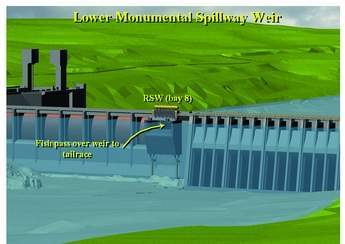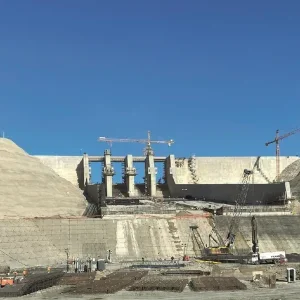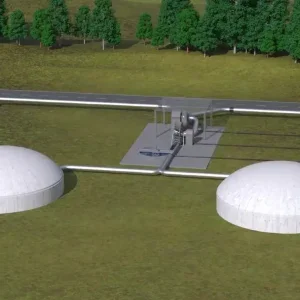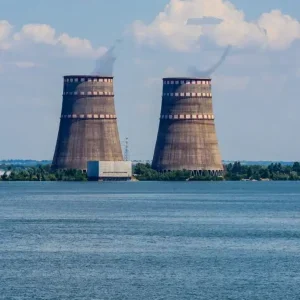
After reaching a level of maturity, juvenile salmon and steelhead in the American Pacific Northwest begin a migration from the fresh water streams and rivers to the Pacific Ocean. Fish that are reared in fresh water, reach maturity in salt water, and then return to fresh water as spawning adults are called anadromous fish. Historically, millions of salmon and steelhead have used these rivers for rearing and spawning habitat, as well as the pathway to the fertile feeding grounds in the oceans. These fish had unimpeded passage downstream to the ocean and back upstream to their rearing grounds as adults.
As the Pacific Northwest became inhabited and tamed by early pioneers, many human factors contributed to a severe decline in the numbers of these species. Commercial fishing and massive canneries nearly drove salmon and steelhead to extinction by the early 1900s. Logging practices over the last 150 years has damaged lands adjacent to spawning grounds and reduced water quality needed for spawning and rearing of the juvenile fish. Ranching and farming practices have introduced biological waste and chemical pollutants into the river systems and made river banks unstable allowing silt to be deposited into the once clear-running streams. Other species of fish have been intentionally or unwittingly introduced into the river basins. The newcomers have increased predation, added competition for food, and reduced spawning areas needed to sustain indigenous fish populations. Water needed for farming has reduced the river flows and increased water temperatures of the streams and rivers. Severe drought periods have also played a negative role in fish survival, compounded by the human demand for water.
In addition to all these factors, major hydroelectric dams were introduced into the lower Columbia river, starting at Bonneville dam in the 1930s and continuing in all major and minor tributaries in the Pacific Northwest basins. By the late 1970s, hundreds of dams of various sizes were built in areas that were once free-flowing streams, creating impediments for anadromous fish migrations.
Many of the dams, and all the large Federal dams on the Columbia and Snake rivers, were constructed with fish ‘ladders’ to allow adult fish to return from the ocean to their natural spawning grounds. These ladders provide for upstream migration of adult fish, with approximately 99% survival of adults passing upstream of any single dam. Throughout the system of dams from Bonneville to Lower Granite, the survival of adult fish using the ladders is around 90%.
The original dam designs did not consider juvenile fish passage downstream to the ocean. It was assumed that the millions of small fish could successfully pass through the turbines and spillways with acceptable levels of injury or mortality.
By the late 1970s the fish runs experienced a sharp decline in returning adult salmon and steelhead. Because of the combinations of factors that existed at the time, the cause of the sharp decline was not completely understood. It is now believed that the gradual pace of installing power generation equipment at the dams as they were being constructed, with water pouring through spillbays, led to supersaturation of nitrogen gas in the river water. In addition to the other factors that were damaging fish runs, completion of four dams on the lower Snake river from 1961 through 1974, combined with severe drought periods, compounded the decline and brought the issue to national attention.
This attention caused several actions at dams operated by the federal government. Biologists and engineers devised a system of collecting and transporting fish to the oceans via highway and river barges to reduce the numbers of fish passing through the turbines. Spilling at the dams was implemented to pass fish during peaks of migration in the spring. Spilling practices have now increased to a point where some dams are operated more for fish passage than for power generation. In some cases, the operations used for fish passage were not understood and actually added to the harm caused to fish. It was discovered that spilling large quantities of water resulted in supersaturating the waters with dissolved nitrogen and other gases, injuring and killing fish. Spill practices are now being managed to reduce levels of dissolved gas, however, this costs the power marketing agencies more than US$100M annually in ‘lost opportunity’ power generation. These costs are passed on to the region’s citizens and electrical ratepayers.
Since the 1970s, many other actions have improved juvenile fish survival at the dams. In addition to the fish collection and transport systems, spillways have been successfully modified at many locations. Bypass systems have been added at turbine intakes that guide fish away from the turbines and into pipes and flumes to be released into the tailraces below the dams. Spilling practices have been shaped to reduce dissolved gases in the river to levels that lower mortality of juvenile fish. Causes of injury and mortality have been identified over time, prompting operations of turbines and spillways to reduce harm to the fish. These and other improvements have raised direct survival at the dams to well over 90%. While this seems high, many fish are injured or die in the long journeys between dams, by natural causes and especially due to predation by fish and birds. It has been estimated that it takes 5000 eggs for the eventual reward of two returning pairs of adult fish. It follows that large numbers of migrating juveniles are needed to sustain a returning adult population. Even a small percentage of mortality can equate to hundreds of thousands of lost juvenile fish.
Despite better understanding of the effects of spillway and powerhouse operations, fish passage at hydroelectric dams remains a contentious scientific, political and legal debate.
Surface passage
In the 1990s efforts began to create ‘surface passage’ methods as an efficient and effective way to allow fish to pass the dams. With research, it was discovered that a high percentage of the fish populations travel in the upper 30ft (9m) of the water column as they migrate downstream to the ocean. Because of the dams’ design and configuration, spillways and the turbines result in juvenile fish diving to depths of 50-60ft (15-18m) to find the passage routes. Engineers and biologists began pursuing new technologies that would provide more surface-oriented passage routes for juvenile fish.
To test the effectiveness of surface passage, a prototype ‘surface collector’ was installed at Lower Granite dam on the lower Snake river in 1996. Successful testing of the surface collector led to the full scale installation and testing of the prototype ‘removable spillway weir’ (RSW) at Lower Granite in 2001. The spillway weir allows juvenile salmon and steelhead to pass the dam near the water surface under lower accelerations and lower pressures, providing a safe and efficient passage route over the dam. The design of the spillway weir is different from existing spillways with gates that open 50ft (15m) below the water surface at the face of the dam and pass juvenile fish under high pressure and great velocities. The spillway weir, however, passes juvenile salmon and steelhead over a raised spillway crest, similar to a waterslide. To maintain the original capacity of the spillways for flood passage, the structure is designed to be removable by controlled descent to the bottom of the dam forebay.
The prototype weir installed in 2001 at Lower Granite dam was considered a success, safely passing large numbers of juvenile fish, reducing delays at the dams, and providing a much more efficient spillway route than previous operations.
A second spillway weir was installed at Ice Harbor dam in 2005, and a third is being installed at Lower Monumental dam this year.
When the system is completed on the Lower Snake river, adult fish will continue to pass upstream by ladders, and many juvenile fish can pass by spillway weirs downstream. Other surface bypass methods are being considered and implemented on the Lower Columbia river and at other non-Federal dams in the region.
RSW installation at lower monumental dam
As mentioned above, the RSW structure designed for Lower Monumental Dam is the third such mechanism planned for installation at the lower Snake river dams. Because of the remote location of the hydro power sites on the river, the RSW’s are fabricated off-site and transported via river to the dam for installation. Considerable site preparations are necessary to make the spillway bay ready for the massive structure to be installed. Fabrication capability for the Lower Monumental RSW has come from the Portland, Oregon metropolitan area, more than 280 river miles from the installation site.
The RSW’s are designed for fish passage, but occupy a spillway bay needed to pass the full capacity of the river in the event of a flood. This requires the RSW to be removable, allowing the entire steel structure to be rotated in an upstream and descending arc and perched on a ‘landing pad’ on the river bottom. The RSW is designed as a massive door, hinged near the toe of the dam, with the ability to transition from an upright deployed position to a resting stowed position, nearly 90° off vertical. The RSW utilises the same technology as a submarine, with water ballast and air delivery systems designed to control a slow rotation of the weir from an operation position to the removed position. This combination of innovative engineering and environmental purpose earned the design the ‘Grand Conceptor’ award, the highest engineering design achievement given by the American Council of Engineering Companies in 2003.
Remote fabrication
The RSW vessel, when fully assembled, weighs more than two million pounds. This steel structure is much too large to fabricate in one location. Components of the structure are broken down into about 12 separate assemblies, each built to tight tolerances for precision fit-up to the other massive components. These pieces are built in separate bays or at nearby facilities, and then transported by truck and rail and positioned by cranes in the assembly areas. After full assembly, the entire RSW is sandblasted and painted on every exposed area, inside and out. The marine coatings used require extreme surface preparation and precision applications for corrosion resistance during the life of the structure. To improve environmental conditions needed for the coating applications, the assembled RSW is shrouded in shrink-wrap plastics over huge scaffold systems. The sandblasting and coating operation takes approximately one month.
Land transport
When coating operations are complete, and the scaffolding systems are removed, the RSW is ready for transportation. The structure is raised high enough to place hydraulic dollies underneath in an orchestrated system that allows complete driving control on land, but at a snail’s pace. The RSW is rolled onto a floating river barge. The barge is towed into a large dry dock facility and then sunk when the dry dock is lowered. Even though the RSW would tip a very large scale at 1000 tons, it rises in the water from the support cradle used during land transport. Now free and floating independently, the RSW structure is hinged to tandem grain barges and two tug boats, one positioned at either end of the haul.
River transport
A system of locks and dams allows commercial navigation from the Pacific Ocean through the Columbia river and into the Snake river, ending about 30 miles (48km) upstream of the Lower Granite dam near Lewiston, Idaho. This system was used to transport the first two Walla Walla District RSW’s in 2001 and 2005, and will be used for the third in the Fall of 2007 to get to Lower Monumental dam. RSW’s are designed to function as a vessel during river transport. This is the only viable means of transporting the device to the project site. This requires the structure to be buoyant enough to float with a draft of less than 14ft (4.3m), the minimum channel depth maintained for navigation in the river system. During the short four-day river voyage to Lower Monumental dam, the RSW will traverse through six high-lift locks on its way to the installation site. These locks are 86ft (26m) wide and lift vessels as high as 102ft (31m) as they pass through the single-lift lock system. The RSW must be narrow enough to fit through the lock system during the transportation phase. There are about 11 inches of clearance on the port and starboard sides between the tow assembly and the lock walls.
Site preparations
Numerous preparations are conducted at the project site while the RSW is being fabricated. Extensive deep-water diving operations are needed to install bottom supports for the hinges and the landing pad supports. The spillway piers are modified with steel and grout seal beams that dovetail precisely with the large operational part of the structure being assembled hundreds of miles away in the Portland area. Installation of column supports on the river bottom are placed in depths approximately 120ft (36.6m) below the river surface. This coordinated effort is conducted in approximately six months concurrent with the fabrication of the larger RSW components. The concrete-filled columns are precision placements that have to work perfectly with the RSW hinge locations. The support columns and braces attached to the dam support the full vertical weight of the RSW, but they must also resist a powerful horizontal hydraulic load should the RSW be subjected to large flood flows while stowed at the bottom of the dam’s forebay.
Installation
Once the RSW has traversed the many miles through the river system, it is carefully positioned upstream of the dam with the full river tow assembly of tugs and grain barges. This assembly offers a stable platform to make a transition from the tow arrangement to the installed position. The tugs position the RSW and grain barges to the spillway bay, then a series of winches are used to both draw the RSW closer to the dam, and to draw the two ‘feet’ of the RSW downward to the deep hinge supports. The ballast systems of the structure maintain a slightly positive buoyancy, and the cables are used to pull and position the structure. Once drawn to the hinges, they are pinned together. During this operation the RSW is detached from the barges and tugs. Once free of the river transport system, the RSW is nearly complete and ready for operation. Final fitting and sealing is conducted for several weeks, and when the grout is cured, the system is ready for use.
Operation
The RSW functions in the upright deployed position at all times. Flow over the weir is turned on and off by closing an existing radial gate that is located inches below the bottom of the RSW slide. The RSW passes approximately 8500ft3/sec (240m3/sec) of flow, which is about 10% of the average total river volume. The RSW passes large numbers of juvenile fish because they are attracted by the current of the surface flow created by the weir. Juvenile steelhead and salmon tend to migrate toward the ocean by swimming near the river surface, so surface flow is favoured over deep flow routes that exist at power house intakes and gated spillway bays. When needed for flood passage, the RSW is slowly sunk to the river bottom using the submarine ballast techniques used to overcome the positive buoyancy of the structure. Through a series of ballast tanks and air tanks, the RSW rotation and position are guided by a programmable logic controller, a small computer that delivers air or water as needed to control the descent. A flood event of the magnitude needed to stow the RSW to the river bottom is not a frequent occurrence, but testing has verified the system can be removed if needed. The RSW stow operation takes approximately 12 hours.
Kevin Crum, Project Manager, Walla Walla District, US Army Corps of Engineers. www.nww.usace.army.mil






